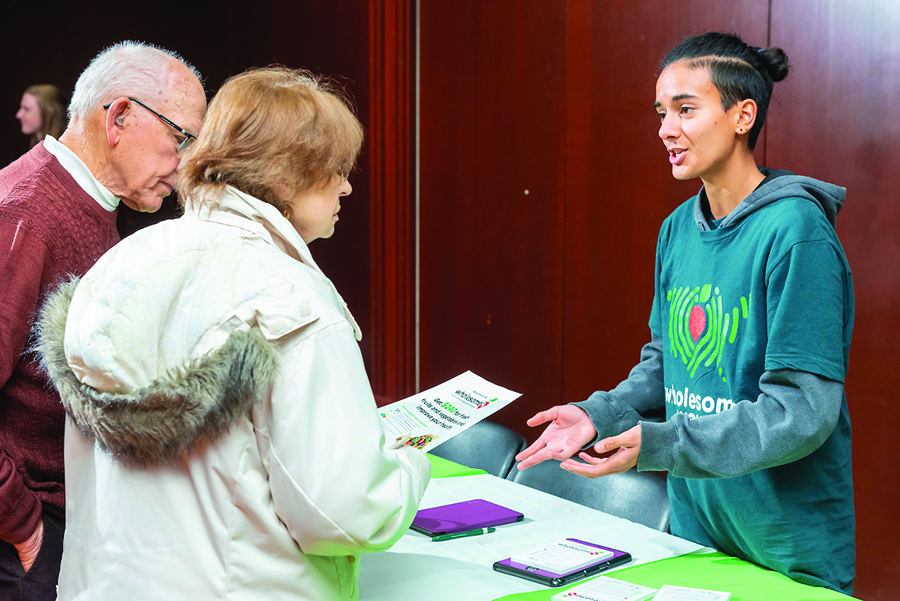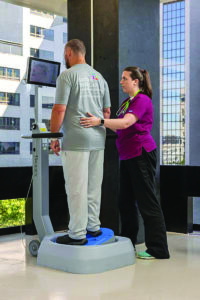Community Care
Photo by Laura Davidson
St. Vincent’s Monthly Food Distribution
By Edna M. Borchetta, mission services and community outreach specialist, Fairfield Region
St. Vincent’s food distribution volunteers — representing multiple departments and levels of the organization – are all smiles under their masks after safely distributing 400 bags of groceries to neighbors in need.
In 2019, in partnership with the Connecticut Food Bank, St. Vincent’s Medical Center (SVMC) launched its first Mobile Food Pantry, a monthly distribution providing free, essential and healthy food to our neighbors most in need.
When the coronavirus prompted widespread shutdowns of all but essential services in March 2020, the Mission Services team knew the most vulnerable people in our communities would be disproportionately affected by the health crisis. Many food pantries closed and the mobile pantries were greatly reduced. St. Vincent’s monthly Mobile Food Pantry was also in jeopardy. The team needed to solve two problems:
• How to continue sourcing food for distribution
• How to distribute food safely during the pandemic
With funding from the SVMC Foundation, the Mobile Food Pantry was reimagined in June 2020 as a COVID-19 safe drive-through/walk-up monthly food distribution. Each family received a bag of healthy, shelf-stable food items, milk, eggs and fresh bread. Staff volunteers helped with preparation and distribution of at least 300 bags of food.
On the one-year anniversary of our partnership with Hartford HealthCare, HHC President and CEO Jeffrey Flaks further demonstrated our health system’s support of our community by making a $50,000 donation to the Bishop Jean Williams Food Pantry. This helped fund the purchase of 120,000 pounds of food to provide more than 100,000 nutritious meals to those served by the pantry.
Prescribing health for diabetics
By Brenda Kestenbaum

More than 400,000 Connecticut residents struggle with hunger and many must choose between food and other necessities such as housing, utilities and healthcare.
For diabetics, the struggle can be even more acute, but through a collaboration between Whole- some Wave and Hartford Hospital, healthcare providers are writing prescriptions for produce for patients with diabetes. Wholesome Communities Connecticut was implemented through work by Wholesome Wave teams and the hospital’s Adult Primary Care and Diabetes Life Care clinicians. The cost of the program and produce is covered by the hospital.
Registered patients facing food insecurity and unmanaged diabetes can receive $60 in Wholesome Rx vouchers monthly to buy fresh fruits and vegetables at C-Town and Hartford Mobile Market Stops.
Monthly vouchers can be refilled by meeting with clinicians or attending nutrition education classes. Data from all activities is collected and evaluated as part of the initiative’s effort to inform, activate and measure. This, organizers believe, helps increase the diabetic patient’s consumption of fruits and vegetables, which can help reduce healthcare costs and use.
This initiative builds upon Wholesome Wave’s successful three-year produce incentive program, funded by the USDA in Hartford and Vermont.
About 330 people with diabetes participate, and Wholesome Wave Director of Program Partner- ships David Juros hopes to expand program reach to up to 350 women and families through the Women’s Ambulatory Clinic.
Photo by Chris Rakoczy
Mystic rehab leads state in technology investment
By Elissa Bass

Kaitlyn O’Gara, PT, right, works on a balance device with patient Clayton Rogers Shaw at the Inpatient Rehabilitation Unit at Hartford Hospital.
The Hartford Healthcare Rehabilitation Network (HHCRN) outpatient clinic in Mystic boasts the most cutting-edge equipment in Connecticut.
Including the latest state-of-the-art rehabilitation equipment available was part of the plan to support development of strong neurologic services in the region, according to HHCRN Regional Director Anthony Falcigno.
“Having the right tools and equipment, along with highly-specialized and trained staff passionate about these types of conditions, makes for a top experience for patients,” Falcigno said. “Offering PT, OT and speech patients such advanced treatment in the same location as many of their healthcare providers makes for a more coordinated, multidisciplinary team approach to their care.”
The LiteGait® training device, for example, simultaneously controls patient weight bearing, posture and balance over a treadmill or ground to facilitate lower extremity movement training.
In addition, Mystic offers the region’s only:
• Functional electrical stimulation bicycle, which applies small electrical pulses to paralyzed muscles to restore or improve function.
• Bioness Wireless Hand Rehabilitation System, which delivers low-level electrical stimulation to activate nerves controlling muscles in hands and forearms.
• Parkinson Voice Project’s “Speak Out” program, which offers intensive speech, voice and cognitive exercises.
“My first day, I actually became emotional looking at all the equipment we have here. Hartford HealthCare is so invested in this population, and provides so many amazing opportunities for people to make real gains,” said Occupational Therapist Mandy Lacey.
Photo by Tim Lebouthillier
Night nurse turned VP reflects on career of caring
By Tim Lebouthillier
John Capobianco has changed jobs but not commitment to Charlotte Hungerford Hospital.
Community hospitals thrive when leaders understand the importance of strong, meaningful relationships with staff, community and partners. John Capobianco, regional vice president of operations at Charlotte Hungerford Hospital (CHH), could write a book on it.
Capobianco recently celebrated 35 years of service at CHH, beginning as a nurse working nights and weekends. He also served as nursing unit manager, director of nursing operations and
director of projects and systems for patient operations before joining the senior administrative team in 1998.
Over the years, he managed multiple priorities focused on his main goal — ensuring the best patient care. Priorities include maintaining CHH’s financial stability, enhancing technology, improving diagnostics and expanding services. When asked, he credited others — administrators, providers and staff — with keeping CHH on track through the years.
Personally, Capobianco is most proud of developing and expanding CHH’s ambulatory footprint and developing deep connections in the community, including as a founding board member of Torrington’s first federal qualified health center. Whether it’s repurposing a former hospital in Winsted, creating a cancer center from scratch or transforming a bank branch to a behavioral health center for children and families, he has a unique and respected talent for bringing ideas to fruition.
He has also enjoyed being an active contributor and supporter of numerous non- profit community and healthcare organizations in northwest Connecticut.
What Capobianco enjoys most about his position, though, is the people.
“My best memories, past and present, all revolve around the staff and the wonderful culture we have at Charlotte. I have been privileged to work with so many dedicated caregivers and staff, who put each other, the patients and our community first,” he said.
Looking back, he and CHH colleagues weathered many challenges while administering through lengthy economic downturns, unexpected natural disasters and, most recently, the COVID-19 pandemic. Through it all, Capobianco said the uncertainty of COVID stands out.
“This has really stretched us all and tested our healthcare systems and society as a whole. But to see our staff work so tirelessly and our community come together, day after day, keeps us all going. It’s still a marathon, but we have quite a team of runners!” he laughed.
